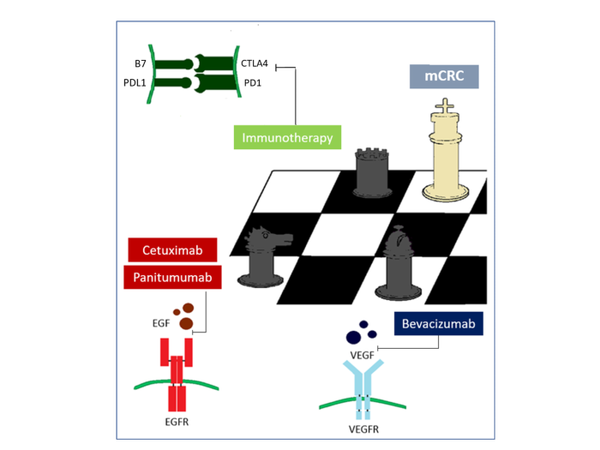-
Home
-
About JCTR
-
Gold Open Access
-
Issues
-
Editorial board
-
Author guidelines
-
Publication fees
-
Online first
-
Special issues
-
News
-
Publication ethics
-
Partners
-
Submit your manuscript
-
Submit your review report
-
Editorial Office
-

This work is licensed under a Creative Commons Attribution-NonCommercial 4.0 International License. ISSN print: 2382-6533 ISSN online: 2424-810X
Volume 7 Issue 6
Personalizing first-line treatment in advanced colorectal cancer: current status and future perspectives
Rodrigo Motta, Santiago Cabezas-Camarero, Cesar Torres-Mattos, Alejandro Riquelme, Ana Calle, Paola Montenegro, Miguel J. Sotelo*
Motta et al. J Clin Transl Res 2021; 7(6):11
Published online: November 29, 2021
Abstract
Background: Colorectal cancer is one of the most frequent neoplasms worldwide and the majority of patients are diagnosed in advanced stages. Metastatic colorectal cancer (mCRC) harbors several mutations with different prognostic and predictive values; KRAS, NRAS, and BRAF mutations are the best known. Indeed, RAS and BRAF molecular status are associated with a different response to monoclonal antibodies (Anti-EGFR and anti-VEGFR agents), which are usually added to chemotherapy in first-line, and thus allow to select the optimal therapy for patients with mCRC. Furthermore, sidedness is an important predictive and prognostic factor in mCRC, which is explained by the different molecular profile of left and right-sided tumors. Recently, microsatellite instability-high (MSI-H) has emerged as a predictive factor of response and survival from immune checkpoint inhibitors (ICIs) in mCRC. Finally, several other alterations have been described in lower frequencies, such as HER2 overexpression/amplification, PIK3CA pathway alterations, PTEN loss and HGF/MET pathway dysregulation, with several targeted therapies already demonstrating activity or being tested in currently ongoing clinical trials.
Aim: To review the importance of studying the predictive and prognostic roles of the molecular profile of mCRC, the changes occurred in recent years and how they would potentially change in the near future, in order to guide physicians in treatment decisions.
Relevance for patients: Today, several different therapeutic options can be offered to patients in the first-line setting of mCRC. Therapies currently approved or under investigation in clinical trials will be thoroughly reviewed, with special emphasis on the molecular rationale behind them. Understanding the molecular status, resistance mechanisms and potential new druggable targets may allow physicians to choose the best therapeutic option in first-line mCRC.

DOI: http://dx.doi.org/10.18053/jctres.07.202106.011
Author affiliation
1 Department of Medical Oncology, Aliada Cancer Center; Lima, Peru.
2 Instituto Nacional de Enfermedades Neoplasicas; Lima, Peru.
3 Department of Medical Oncology, Hospital Universitario Clínico San Carlos; Instituto de Investigación Sanitaria San Carlos, Madrid, Spain
4 Department of Medical Oncology, Hospital Nacional Guillermo Almenara Irigoyen; Lima, Peru.
5 Oncological Research Unit, Clínica San Gabriel, Lima, Peru.
6 Department of Medical Oncology, Hospital Universitario Infanta Cristina; Madrid, Spain.
7 Department of Medical Oncology, Hospital María Auxiliadora; Lima, Peru.
8 Auna-OncoSalud Network, Lima, Peru.
*Corresponding author
Miguel J. Sotelo
Department of Medical Oncology, Hospital María Auxiliadora; Centro Oncológico Aliada; Oncological Research Unit, Clínica San Gabriel; Avda. Miguel Iglesias 968, San Juan de Miraflores, Lima 15801, Peru.
Email: miguel.sotelo.lezama@gmail.com
Handling editor:
Michal Heger
Department of Pharmaceutics, Utrecht University, the Netherlands
Department of Pharmaceutics, Jiaxing University Medical College, Zhejiang, China

